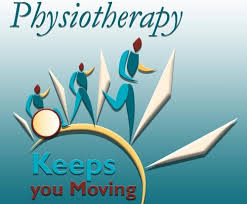
About Physiotherapy
Physical therapy (PT), mostly known as Physiotherapy, is a primary care specialty in western medicine that, by using mechanical force and movements [Bio-mechanics or Kinesiology], Manual therapy, exercise therapy, electrotherapy, and various physical therapies who practice evidence-based treatments, remediates impairments and promotes mobility, function, and quality of life through examination, diagnosis, prognosis, and physical intervention. It is performed by physical therapists (known as physiotherapists).
DEFINITION OF PHYSIOTHERAPY ACCORDING TO W.H.O. Physiotherapists assess, plan, and implement rehabilitative programs that improve or restore human motor functions, maximize movement ability, relieve pain syndromes, and treat or prevent physical challenges associated with injuries, diseases, and other impairments.
The treatment of disease, injury, or deformity by physical methods such as massage, heat treatment, and exercise rather than by drugs or surgery. US term physical therapy. ‘Recovery can be aided by speech therapy, physiotherapy, occupational therapy, and counseling.’
In physical therapy, trained professionals evaluate and treat abnormal physical functions related to, for example, an injury, disability, disease, or condition.
Physiotherapists help people affected by injury, illness, or disability through movement and exercise, manual therapy, education, and advice. They maintain health for people of all ages, helping patients to manage pain and prevent disease.

Click here for Types of Physical therapy and benefits
Orthopedic physical therapy treats musculoskeletal injuries, involving the muscles, bones, ligaments, fascias, and tendons. It is suitable for medical conditions such as fractures, sprains, tendonitis, bursitis, chronic medical problems, and rehabilitation or recovery from orthopedic surgery.
Geriatric physical therapy can help older patients who develop conditions that affect their mobility and physical function, including arthritis, osteoporosis, Alzheimer’s disease, hip, and joint replacement, balance disorders, and incontinence.
Neurological physical therapy can help people with neurological disorders and conditions such as Alzheimer’s disease, brain injury, cerebral palsy, multiple sclerosis, Parkinson’s disease, spinal cord injury, and stroke.
Cardiovascular and pulmonary rehabilitation can benefit people affected by some cardiopulmonary conditions and surgical procedures.
Pediatric physical therapy aims to diagnose, treat, and manage conditions that affect infants, children, and adolescents, including developmental delays, cerebral palsy, spina bifida, torticollis, and other conditions that impact the musculoskeletal system.
Wound care therapy can help to ensure that a healing wound is receiving adequate oxygen and blood by way of improved circulation. Physical therapy may include the use of manual therapies, electric stimulation, compression therapy, and wound care.
Vestibular therapy aims to treat balance problems that can result from inner ear conditions. Vestibular physical therapy involves a number of exercises and manual techniques.
Decongestive therapy can help to drain accumulated fluid in patients with lymphedema and other conditions that involve fluid accumulation.
Pelvic floor rehabilitation can help treat urinary or fecal incontinence, urinary urgency, and pelvic pain in men and women as a result of injuries or surgery, or because of certain conditions.
A sports therapist can help an athlete to maximize their performance through strengthening specific parts of the body and using muscles in new ways.
A healthcare provider or physical therapist can advise individuals about the benefits specific to their personal medical history and their need for treatment.
Benefits of physiotherapy therapy
Depending on the reason for treatment, the benefits of physical therapy include:
- Pain management with reduced need for opioids
- Avoiding surgery
- It ensures slow, Steady, and Sustainable repair of the body
- Relieve pain caused by Surgery or Medical Problems
- Improved mobility and movement
- Recovery from injury or trauma
- Increased recovery rate
- Specialized approach for each person
- Helps children to reduce spasticity, deformity and improving postural control
- Recovery from stroke or paralysis
- Fall prevention
- Reduces stress and anxiety
- Improved balance
- Management of age-related medical problems
- Promote independently maintained healthy physical lifestyles
- Helps Children to improve postural control
- Train the child to use assistive devices
- Maximize independence
- Improve basic functions such as Standing, Walking, and grasping
A touch of care.
- Caring is passion.
- Don’t let pain keep you for life.
- Enriching lives through physical independence.
- Excellence driven. Superior results.
- Genuine commitment to your health.
- Get back your active life.
- Get Up! Get here! Get better!
- Getting better every day.
- Helping people take steps towards independence.
- Helping you, help yourself.
- Hope for a better tomorrow.
- It’s about life… As you remember it.
- Moving you to better health.
- One to One Hands-On Care.
- Quality care for a better quality of life.
- Quality care from people who care.
- Recover independence and get back to the life you love.
- Relieve pain. Regain your life.
- Strength, Mobility, Function, Life.
- Teaching you today what you need to know tomorrow.
- The best hour of your day, every day.
- The results you want. The care you deserve.
- The road to recovery starts here.

Myths about Physiotherapy
It’s time to debunk 7 common myths about physical therapy:
Myth #1: I need a referral to see a physical therapist.
Fact: A recent survey by the American Physical Therapy Association (APTA) revealed 70% of people think a referral or prescription is required for evaluation by a physical therapist. However, a physician’s referral is not required in order to be evaluated by a physical therapist.
Myth #2: Physical therapy is painful.
Fact: Physical therapists seek to minimize your pain and discomfort—including chronic or long-term pain. They work within your pain threshold to help you heal, and restore movement and function. The survey found that although 71% of people who have never visited a physical therapist think physical therapy is painful, that number significantly decreases among patients who have seen a physical therapist in the past.
Myth #3: Physical therapy is only for injuries and accidents.
Fact: Physical therapists do a lot more than just stretch or strengthen weak muscles after an injury or surgery. They are skilled at evaluating and diagnosing potential problems before they lead to more serious injuries or disabling conditions—from carpal tunnel syndrome and frozen shoulder to chronic headaches and lower back pain, to name a few.
Myth #4: Any health care professional can perform physical therapy.
Fact: Although 42% of consumers know that physical therapy can only be performed by a licensed physical therapist, 37% still believe other health care professionals can also administer physical therapy. Many physical therapists also pursue board certification in specific areas such as neurology, orthopedics, sports, or women’s health, for example.
Myth #5: Physical therapy isn’t covered by insurance.
Fact: Most insurance policies cover some form of physical therapy. Beyond insurance coverage, physical therapy has proven to reduce costs by helping people avoid unnecessary imaging scans, surgery, or prescription drugs. Physical therapy can also lower costs by helping patients avoid falls or by addressing conditions before they become chronic.
Myth #6: Surgery is my only option.
Fact: In many cases, physical therapy has been shown to be as effective as surgery in treating a wide range of conditions—from rotator cuff tears and degenerative disk disease, to meniscal tears and some forms of knee osteoarthritis. Those who have recently seen a physical therapist know this to be true, with 79% believing physical therapy can provide an alternative to surgery.
Myth #7: I can do physical therapy myself.
Fact: Your participation is key to a successful treatment plan, but every patient still needs the expert care and guidance of a licensed physical therapist. Your therapist will leverage his or her specialized education, clinical expertise, and the latest available evidence to evaluate your needs and make a diagnosis before creating an individualized plan of care. [/expand]